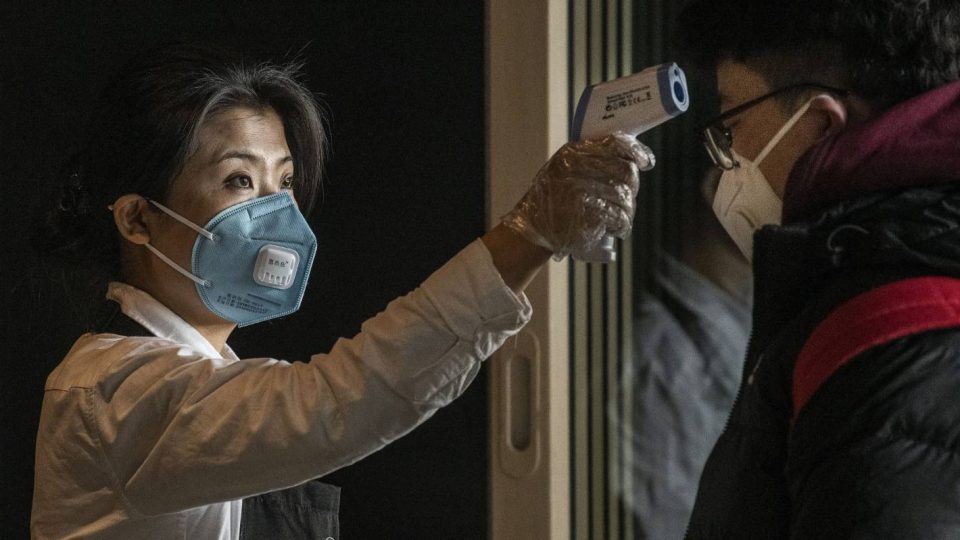KEGIN FRAYER/GETTY IMAGES
A Starbucks worker checks the temperature of a customer at Beijing Capital Airport. More than 100 cases of coronavirus have been confirmed in the city.
“Prediction is very difficult, especially about the future”. So goes a quote often attributed (but of uncertain provenance) to the famous physicist and philosopher Niels Bohr.
And so it was with my previous article a fortnight ago, which made predictions about key events in Asia in 2020. My list of “things to watch” didn’t mention an epidemic originating in China.
At that point, the new coronavirus was still seen as a relatively local issue linked to a single market in Wuhan. But perhaps it should have been on my radar regardless, given it was just a few days ahead of the lunar new year. China’s new year festivities are estimated to create about 3 billion trips annually and are often described as the largest annual human migration in the world.
We know from Sars (which originated in China in 2002), swine flu (first identified in Mexico in 2009), and MERS (starting in the Middle East in 2012) that seemingly localised respiratory infections can quickly evolve to significant international events.
READ MORE:
* Protests, trade and assertiveness for Asia in the next decade
* Kiwi businesses need to make big decisions as New Zealand builds ties with Asia
* Asia’s long-term planning is paying off; New Zealand must learn from it
The emergence of the novel coronavirus 2019-nCoV and its spread to both close and distant countries demonstrates the incredibly interconnected world we all live in. The spread of the virus, in spite of the Chinese government’s attempt to quarantine some 11 million people in Wuhan, is a salutary reminder that the borders we think of as being very real are in fact artificial human constructs that nature ignores.
Just as the virus ignores borders, so too its effects are stretching way beyond Wuhan. We know from previous cases that epidemics can affect our trade and tourism. Although the economic impact of Sars in New Zealand was relatively short-lived, that virus was estimated to have wiped $40 billion from world markets. And New Zealand’s connectedness to Asia has grown significantly since 2003.
Events of the last few weeks are another reminder of why the ‘rules-based order’ we hear international leaders talk about is so relevant even to small and seemingly distant countries like New Zealand.
1 NEWS
The virus originated in Wuhan, China with many people dead and thousands infected.
With inter-connectedness being what it is in 2020, having agreed rules on how to respond to pandemics; how to deal with the climate issues and plastics; preventing corruption and crime; and doing business are more important now than ever. Standing alone is simply not an option. Indeed, I am reminded that the North Korean political programme of ‘Juche’ – which can be translated as ‘self-reliance’ and cutting itself off from the world – is one of the reasons it is one of the most repressive and poorest places in the world.
On a brighter note, we have recently seen some good, if unheralded, efforts in New Zealand and internationally to bolster some of the rules that help facilitate business. In the past fortnight, the New Zealand, Singaporean and Chilean governments have concluded an agreement to make it easier for small and medium businesses to engage in digital trade. This is particularly important for New Zealand as most of our businesses are small and medium-sized, and digital trade allows them to overcome scale and distance barriers that might otherwise prevent them from entering global markets.
It was these three countries, plus Brunei, that started what was once called the P4, which then grew to become the TPP, and later the CPTPP. So, the hope is that yet again New Zealand is at the table helping write the rules of an important piece of trade architecture that will only attract more governments over time and eventually become a fundamental part of ‘digital international trade rules’.
GETTY IMAGES
A man crosses an empty highway in Wuhan, China, where the coronavirus was first detected.
Meanwhile, businesspeople who rely on the World Trade Organisation for trade access to other markets and to enforce their rights will also be pleased with some positive developments with its Dispute Settlements Body. The body had become unable to perform its functions due to an absence of judges (caused by a US block on judicial appointments). But in the past fortnight, 17 states – including the European Union, China and New Zealand – have agreed to a temporary mechanism that will enable disputes among those parties to be settled consistent with WTO rules, until such time as the Dispute Settlements Body is able to function properly. It is a temporary fix, but a fix nonetheless.
Both these agreements demonstrate a recognition by the countries involved that the ‘inter-connectedness’ that has pretty much defined this century is not going to go away – and that the best thing to do is to keep working on the rules. This will allow us all to maximise the advantages of being interconnected; and manage the disadvantages (like a virus that mutates and ignores borders) when issues arise.
The simple fact is the climate, viruses, electronic transactions – and, increasingly, supply chains – don’t pay much attention to lines drawn on maps months, years or centuries ago.
Simon Draper is the executive director of the Asia New Zealand Foundation Te Whītau Tūhono


